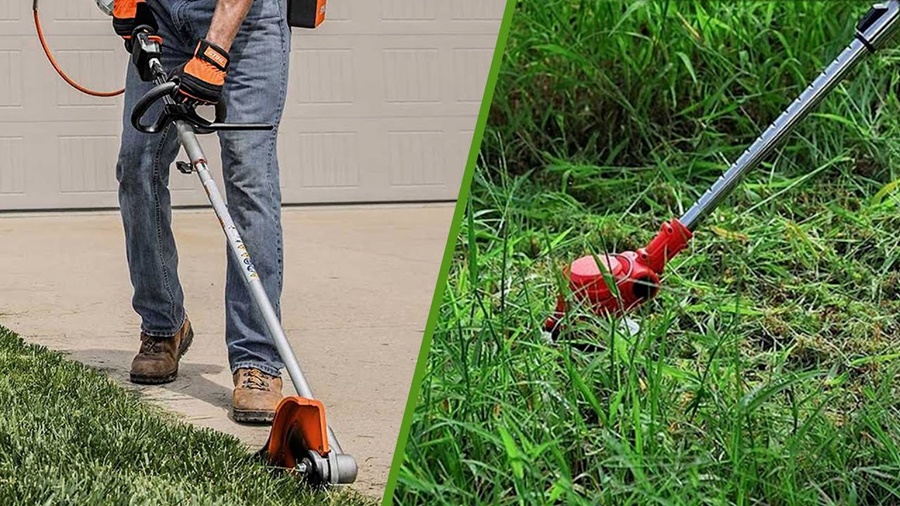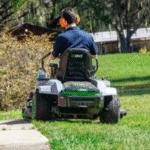Maintaining a perfectly manicured lawn requires more than just regular mowing. For clean lines, trimmed edges, and a polished appearance, two essential tools come into play: the string trimmer and the lawn edger. While both may appear similar to the untrained eye, each serves a distinct purpose. In this comprehensive guide, we’ll break down the differences between string trimmers and lawn edgers, compare their features, and help you determine which tool is right for your landscaping needs.
What Is a String Trimmer?
A string trimmer, also known as a weed eater or weed whacker, is a lightweight landscaping tool designed to cut grass and weeds in hard-to-reach places. It uses a nylon string that spins at high speed, slicing through grass and vegetation.
Main Features of String Trimmers
- Flexible cutting line: Ideal for uneven surfaces and tight spots.
- Curved or straight shaft: Offers different levels of control and reach.
- Gas, electric, or battery-powered: Suited to various property sizes.
- Adjustable head: Some models can double as light edgers.
Best Uses
- Trimming around trees, fences, posts, flower beds.
- Cutting grass where mowers can’t reach.
- Light edging along sidewalks or driveways (with edging feature).
What Is a Lawn Edger?
A lawn edger is a specialized tool designed to create a sharp, clean boundary between your lawn and adjacent surfaces such as driveways, sidewalks, patios, or flower beds. Edgers use either a rotating blade or a manual half-moon blade to cut through soil and overgrown turf.
Main Features of Lawn Edgers
- Vertical spinning blade: Cuts straight down for defined edges.
- Manual or motorized: Motorized for large areas, manual for precision.
- Depth adjustment: Controls how deep the edge is cut.
- Guiding wheel: Maintains straight lines.
Best Uses
- Creating professional-looking lawn boundaries.
- Defining garden beds or walkways.
- Preventing grass overgrowth onto sidewalks and curbs.
String Trimmer vs Lawn Edger: Side-by-Side Comparison
| Feature | String Trimmer | Lawn Edger |
|---|---|---|
| Purpose | Trimming grass and weeds in tight spaces | Creating clean edges along hard surfaces |
| Cutting Mechanism | Spinning nylon string | Vertical metal blade or manual blade |
| Precision | Moderate | High |
| Ease of Use | Lightweight and maneuverable | Slightly heavier, more specialized |
| Versatility | Can trim, edge, and reach corners | Primarily for edging |
| Maintenance | Replace string, battery or fuel | Sharpen or replace blade, engine care |
| Cost | Generally lower | Slightly higher due to specialized function |
Pros and Cons of String Trimmers
Pros
- Versatile: Can cut grass, weeds, and even serve as a light-duty edger.
- Lightweight: Easy to handle for all users.
- Cost-effective: Lower initial investment.
- Battery-operated options: Environmentally friendly and quieter.
Cons
- Less precise edging: Hard to achieve a truly sharp line.
- Line wear: Requires frequent replacement of string.
- Potential for surface damage: Can scuff concrete or bark if misused.
Pros and Cons of Lawn Edgers
Pros
- Sharp, professional finish: Delivers a perfectly defined lawn edge.
- High precision: Ideal for clean lines along walkways and flower beds.
- Long-lasting results: Less frequent edging needed with deep cuts.
Cons
- Limited use: Not designed for general trimming or weeding.
- Heavier and costlier: More expensive and not as versatile.
- Storage space: Takes up more room due to size and design.
Which Tool Do You Need?
Choosing between a string trimmer and a lawn edger depends on your specific landscaping goals.
Choose a String Trimmer If:
- You have a smaller lawn with tight corners and hard-to-reach areas.
- You want a multi-purpose tool for light trimming and edging.
- You prioritize portability and ease of use.
Choose a Lawn Edger If:
- You want perfect, clean lines separating grass from walkways.
- You’re focused on curb appeal and a professional look.
- You have flower beds, driveways, and sidewalks needing precise edges.
For many homeowners, owning both tools can be the ideal solution. Use the string trimmer weekly for quick maintenance, and bring out the edger every couple of weeks for a crisp finish.
Electric vs Gas: Power Source Comparison
Both trimmers and edgers come in electric (corded or cordless) and gas-powered models. Each type has advantages depending on yard size and user preference.
Electric (Corded or Battery)
- Pros: Quiet, lightweight, low maintenance.
- Cons: Limited runtime (battery) or mobility (corded).
Gas-Powered
- Pros: More powerful, great for large yards.
- Cons: Louder, heavier, and requires fuel mix and maintenance.
Pro Tip: For small to medium-sized lawns, a cordless electric combo trimmer/edger can offer excellent flexibility and cost savings.
Safety Considerations
Whether using a trimmer or an edger, safety should always come first. Here are key precautions:
- Wear protective eyewear: Flying debris can cause serious injuries.
- Use gloves and closed-toe shoes: Protects against cuts and impact.
- Check surroundings: Watch for rocks, pets, and children nearby.
- Maintain tools regularly: Sharp blades and fresh trimmer lines ensure efficiency and reduce accidents.
Maintenance and Longevity Tips
Keeping your tools in peak condition not only extends their life but also improves performance.
String Trimmer Maintenance
- Replace worn string regularly.
- Clean head and shaft after each use.
- Lubricate moving parts.
- Store in a dry, cool area.
Lawn Edger Maintenance
- Sharpen or replace blades when dull.
- Clean cutting area thoroughly.
- Check and tighten all fasteners.
- Change spark plug and air filter (gas models).
Proper care can ensure your trimmer or edger lasts 5+ years with consistent performance.
Conclusion
Both the string trimmer and lawn edger play critical roles in achieving a well-groomed landscape. The key difference lies in versatility vs precision. While string trimmers offer greater utility for general lawn maintenance, lawn edgers deliver the clean, defined lines that elevate a yard’s visual appeal.
For most homeowners, investing in both tools — or a 2-in-1 model — provides the best of both worlds. Regular use will keep your lawn looking sharp, healthy, and well-defined throughout the year.








Leave a Reply